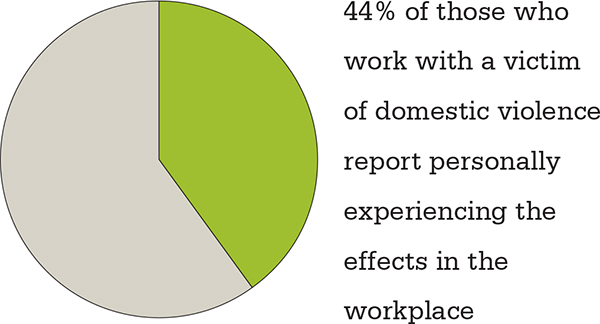
Domestic violence and the workplace
Domestic violence is often considered a dark yet private matter, but the truth is that it has the potential to become a serious workplace issue. Here are some helpful tips on how to handle its impact in the office.
By Bert Alicea, MA, CEAP, Executive Vice President, EAP+Work/Life Services
While domestic violence is often considered a dark yet private matter, the truth is that it has the potential to become a serious workplace issue. Domestic violence follows victims to the workplace, and the effects are devastating to the victim, their coworkers, and the company’s bottom line.
Organizations may employ victims of domestic violence or perpetrators, both of which could lead to lost productivity, legal concerns, other costs, and the potential for an incident in the workplace. However, by implementing prevention and intervention strategies and creating an action plan, brokers and leaders within the organization can help businesses safeguard their employees while minimizing their liability and risk.
The spillover effect
No business is immune to the spillover of domestic violence into the workplace. While domestic violence impacts people of all ages, races and backgrounds, it does affect women more often than men. Overall, 1 in 4 women in the U.S. will be abused by an intimate partner during her lifetime. Among employed adults (men and women), the number is 1 in 5. Alarmingly, the leading cause of death for women at work is homicide.
More than half of the victims surveyed say that their ability to work is affected by domestic violence; an astonishing 75 percent report some form of harassment from their abusers while they are at work. Further, a Harvard University School of Public Health study found that 71 percent of all HR and security personnel reported an incident of domestic violence had occurred on company property.
There is no one root cause of domestic violence; it can stem from a combination of individual, societal, and situational factors. Violence and abuse can be learned behaviors originating from family or community, while other contributing factors can include fragmentation of family structure, easy access to weaponry, TV and other media, an unstable economy, substance abuse, and others.
Within the workplace, violence may be triggered by layoffs or downsizing, insensitive terminations, rigid management styles, lack of individual responsibility where the employee does not feel heard or understood, or office romances, among others. All of these factors can lead to stress, which raises the probability of violence occurring.
Not a personal issue, but a personnel issue
Whether it’s a physical injury, a threatening phone call, stalking in the parking lot, missed work due to abuse at home, stress, or distraction, intimate partner violence can result in high absenteeism and turnover, lost wages, a heightened risk of violence to coworkers, and lost productivity. The price for everyone is steep.
Costs associated with domestic violence can include:
- Lost productivity. In terms of lost productivity alone, businesses pay $729 million each year related to domestic violence, according to the Centers for Disease Control and Prevention (CDC). And nearly 60 percent of employees experiencing domestic violence reported losing their job as a result, either because they were fired or had to quit.
- Health care costs. Health care costs are also higher for domestic violence victims, and employers often pay the price. Victims frequently require medical attention and support as a result of abuse, leading to combined medical and mental healthcare costs of more than $4 billion a year.
- Legal and liability issues. Domestic violence can also expose a company to legal liability, which can carry a hefty price tag, potentially driving employers’ costs up further.
And domestic violence affects both victims and their coworkers. According to a survey conducted by the Corporate Alliance to End Partner Violence, 44 percent of those who worked with a victim of domestic violence reported personally experiencing the effects in the workplace, including concern for their own safety.
Yet, despite the alarming numbers and a growing concern that risk factors such as economic insecurity and job loss could increase threats, the majority of workplaces do not have a program to address domestic violence.
Addressing the problem

It may be surprising, but the U.S. Bureau of Labor reports that only 30 percent of organizations have a workplace violence policy, and only 44 percent of those specifically address domestic violence. While employers are often aware of issues within their organization, they may be reluctant to take action due to uncertainty about their role, among other reasons. However, organizations and their partners have the potential to help prevent issues and support their employees, so it is critical to put a plan in place to address this issue.
By collaborating with employees, management, and other external resources, companies can create and put a comprehensive plan into action that addresses prevention, intervention and response. Key components of this program include:
- Initial assessment – Before creating a policy, work with management to analyze past incidents, assess the potential for issues and assess preparedness. This will ensure the plan is tailored to the organization’s unique needs.
- Multidisciplinary policy – Based on the results of the assessment, this should include how the organization will support victims, including providing security measures, and disciplinary procedures for perpetrators.
- Robust training plan – In order for the policy to be effective, it is important to raise awareness of the issue and educate both managers and employees on how to identify potential situations and respond appropriately.
- Communicate, communicate, communicate – Get the message out to the workforce through a variety of channels, including newsletters, posters in break rooms or restrooms, the intranet and more. This can include information about the company’s program as well as how to access available resources.
Organizations should also understand what resources are available to them and form relationships with groups who can provide a range of support when needed, including an Employee Assistance Program, local domestic violence centers or shelters, and law enforcement personnel.
Domestic violence is a serious issue both in and out of the workplace, but with careful planning and preparation, organizations and their partners can address this important subject and enhance the health and safety of their workforce, reduce the impact on productivity and profitability, and prevent liability.
Domestic violence isn’t just a personal issue — it follows victims to the workplace, leading to devastating effects. Putting an action and response plan in place can help safeguard both employees and organizations.
Five reasons organizations need a domestic violence plan:
- Protect victims – One in five employed adults report being the victim of intimate partner violence. More than half say their ability to work is affected by domestic violence, and an astonishing 75 percent report experiencing harassment from their abusers while at work.
- Protect the workforce – Coworkers of victims report personally experiencing the effects of domestic violence in the workplace, including feeling concerned about their own safety at work.
- Minimize risk and liability – Domestic violence can expose a company to legal liability, including lawsuits and workers’ compensation, especially if there is no plan in place to appropriately respond to issues that may arise.
- Prevent increased health care costs – Victims of domestic abuse require frequent medical attention, which can drive up medical and mental healthcare costs for employers.
- Avoid turnover and lost productivity – Domestic violence impacts victims’ ability to stay engaged at work, leading to lost productivity and even job loss, totaling $729 million a year in costs to businesses.
Original article available here.

